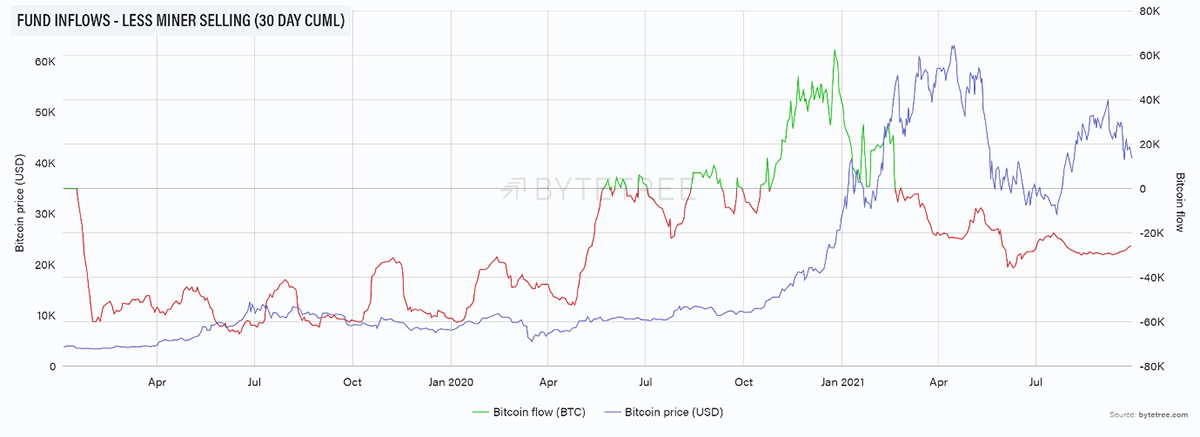The Importance of ETF and Fund Flows of Bitcoin, Ethereum, Gold and Silver

Disclaimer: Your capital is at risk. This is not investment advice.
ByteTree Market Health Update; Issue 94
In free markets, prices are set by supply and demand. Since both crypto and precious metals have limited supply, demand is the most important influence on price. In crypto, the supply side is highly predictable, whereas it is relatively predictable in precious metals. But be sure, if precious metals had an unlimited supply, they wouldn’t be called precious metals.
Measuring demand is complex in all assets, but the beauty of ETFs and funds is that they publish data about their holdings. ETFs are held by institutional and retail investors who have accessed cryptos and precious metals via the stockmarket. This makes them a consistent sample, from a large group of investors, that typically reflects the overall demand for the asset concerned.
The impact on prices because of ETF and fund flows is mixed across different asset classes, depending on the size of the sample. For example, in government bonds or real estate, it is relatively useless information. In major equity markets such as the S&P 500, it has limited value but adds much more value in niche areas such as emerging markets or vibrant sectors.
The ETF and fund holdings are a small part of the overall ownership, but as they grow, it is indicative of where the money is headed – and the same is true in reverse. In crypto and precious metals, this data is gold dust.
The Bitcoin ETFs and funds own around 801,000 BTC, which is 4.3% of the total supply. For Ethereum ETFs, the funds’ combined holdings amount to 3.6% of the total supply. There will be additional holdings via hedge funds where the data is not disclosed. Nevertheless, they strongly indicate overall demand through the millions of investors who engage via the stockmarket. As it turns out, these numbers are quite high in BTC and ETH and have a strong link to price.
The chart shows how BTC ETF holdings ballooned from 250k in 2019 to 800k today. That surge in demand helped drive the bitcoin bull market from $5,000 to $64,0000, before flattening off.

Looking more closely, the changes in bitcoin ETF holdings were linked to the changes in price. When the funds started taking profits in May 2021, the price of bitcoin fell. There were other factors involved, such as increased regulation in China, but ETF investors reacted to the news just as non-ETF investors did at the time. This sample of ETF investors matched the views of the market in general.

Then when the price of bitcoin made a low in July, the ETF investors slowed their selling before accumulating again in September. Currently, that pace of BTC accumulation is slow, but it is upward. Over the past month, the bitcoin ETFs have added 3,040 BTC.
New Bitcoin is mined every ten minutes, and over the past month, that amounts to 27,857 BTC. Therefore, 24,817 BTC were mined, which were not bought by the ETFs and funds. They must have been bought by someone outside of ETFs and Funds.
That balance between bitcoin acquired by ETFs and bitcoin mined is shown below. When green, the funds are buying more bitcoins than miners can supply. When this last happened, a price surge followed, only to cool by April 2021, when fund demand fell back below mine supply.

The Bitcoin Network is currently running at a deficit, which is the norm. If the funds were heavy sellers, that would be bearish, as seen in May this year. But provided the deficit is stable and modest, the impact on price will be slight.
As bitcoin increases in value over the years and becomes more like gold, fund flows will become increasingly important. The gold ETFs have been around since 2003 and have become the most important source of institutional demand. The link between the changes in ounces held by funds and the gold price is strong.

It is estimated that these funds hold around 1.6% of all the world’s gold supply. Since most gold is rarely traded, this number increases when you consider the “active” supply.
With Ethereum, ByteTree calculates that the ETFs hold 4.197 million ETH, which is 3.6% of the total supply. While not quite as high as bitcoin, the link between the ETH price and fund flows also remains strong. Here is the 30-day change in the Ethereum ETF holdings overlaid with the ETH price.

Finally, here are the changes on the silver ETF holdings with a 30-day change. The spike in January came courtesy of the attempted squeeze by Wall Street Bets. Nice try, but it failed to budge the price. These funds hold 868 million ounces of silver, but since an estimated 55 billion ounces have been mined in human history, this is a drop in the ocean. That said, major increases in ETF holdings have driven bull markets.

Summary
ByteTree’s fund flow data provide crypto and precious metals analysts with an important tool to help assess demand. The higher the share of the asset that is held by ETFs, the greater the change in holdings will have on the price.
Some retail investors are rich, but most aren’t. Institutions, on the other hand, are very rich. Tracking where their money is headed is a powerful analytical tool.

Comments ()